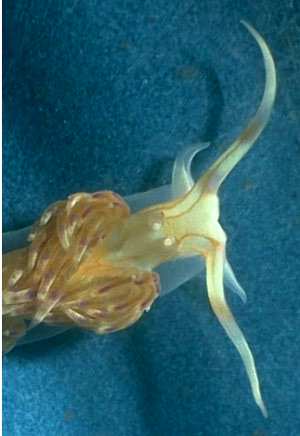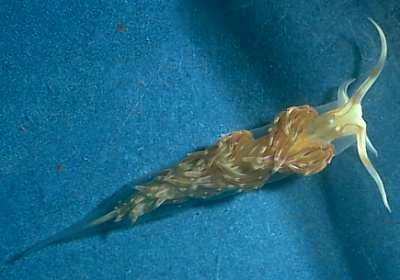
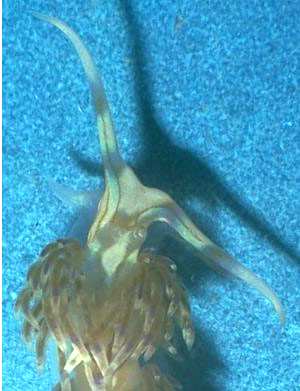
Godiva rachelae
Rudman, 1980
Order: NUDIBRANCHIA
Suborder: AEOLIDINA
Family: Glaucidae
DISTRIBUTION
Probably has a wide Indo-West Pacific distribution. Known from Tanzania and Queensland, Australia.
PHOTO
North Reef (Sewer pipe), Dar es Salaam, Tanzania. 27 September. 1976, 30mm long alive. PHOTO: W.B. Rudman.
The head of the animal is a watery orange with fine deeper orange speckling and a pair of bright orange lines on each side of the head. The area between each pair of lines is milky yellow. The proximal half of the oral tenatacle is a pinkish-purple, except for a patch of millky yellow on the dorsal side. The distal half of the oral tentacle is milky yellow. On each side, from just behind the oral tentacles, a band of milky yellow runs below the cerata to the posterior end of the body. Between each ceratal arch, this yellow band widens. The rest of the body is a pale, watery orange, with a series of markings down the dorsal mid-line. The rhinophores are a watery orange colour with a yellow tip. The foot is translucent white with white patches. The leading edge of the foot and foot corners are milky yellow, and the distal half of the tail is a watery purple. The lower two thirds of the ceratal wall is watery orange. The upper third is transparent, apart from the band of milky yellow just below the tip. The digestive gland appears reddish orange or brownish where masked by the orange ceratal wall, but is a reddish or pinkish purple in the transparent section, the distal part of the digestive gland being a particularly intense purple.
Body elongate and high, growing to at least 37mm long. The rhinophores are long and tapering, appearing slightly wrinkled and annulate in one specimen but smooth in the other two. The oral tentacles are long and slender. The foot is a little wider than the body and at the anterior end the foot corners are long and tapered. The cerata are arranged in 5-7 clusters down each side of the body, each cluster consisting of a multi-rowed arch of cerata on a slightly raised pad. When disturbed, the cerata are held erect, standing 12mm high on a 30mm long animal. At times the animal will swim by lateral flexion of the body.
Egg masses were laid in the aquarium on large hydroid colonies. They form a large, tangled tubular chain of segments containing white eggs. Each segment is approx. 3mm long. Animal was found on the hydroid Eudendrium cf. carneum.
Godiva rachelae agrees in all features with the type-species of the genus, Godiva quadricolor. It differs from that species in colour and in the detailed shape of the radular teeth.
References:
• Rudman, W.B. (1980). Opisthobranch molluscs (Glaucidae) from the Indian Ocean and the south-west Pacific. Zoological Journal of the Linnean Society 68(2), 139-172.
Rudman, W.B., 2002 (February 14) Godiva rachelae Rudman, 1980. [In] Sea Slug Forum. Australian Museum, Sydney. Available from http://www.seaslugforum.net/find/godirach
Related messages
Godiva quadricolor? from sthn Queensland
July 20, 2006
From: Gary Cobb
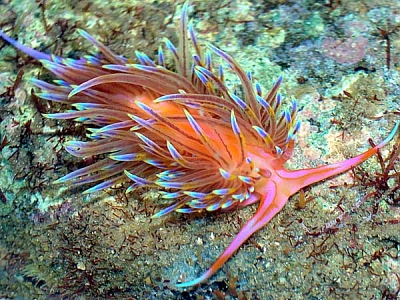
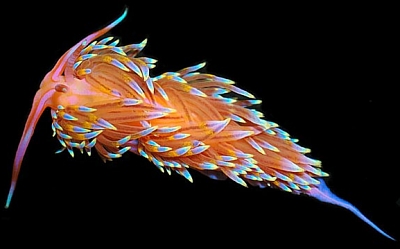
Concerning message #16643:
Hi Bill,
After reading the message on Godiva quadricolor I thought it important to send this message to you. I have drift dived in the Caloundra Pumisestone Passage and found Godiva quadricolor living very well. The animals are by far much more vibrant than any I have seen before.
Locality: Caloundra Pumicestone Passage, 3 m, Queensland, Pacific Ocean, 05 Oct 2004, Subtidal. Length: 58 mm. Photographer: Gary Cobb.
Richard Willan wrote a paper a while ago about the discovery of this species here on the east coast of Australia. I believe the animals are occuring there because the container ships actually turn the marker off the passage entry.
I think this is a new record for eastern Australia!
-
Willan, R.C. 2004. Godiva quadricolor (Barnard, 1927) (Nudibranchia: Facelinidae) spreads into southern Queensland. The Beagle, Records of the Museums and Art Galleries of the Northern Territory, 20: 31-36.
Cheers
Gary
gary@nudibranch.com.au
Cobb, G.C., 2006 (Jul 20) Godiva quadricolor? from sthn Queensland. [Message in] Sea Slug Forum. Australian Museum, Sydney. Available from http://www.seaslugforum.net/find/16770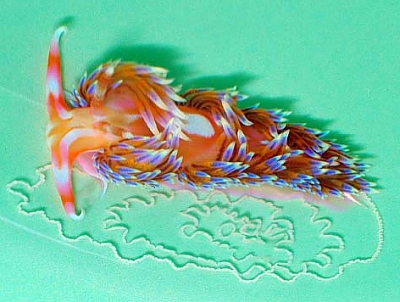
Dear Gary,
Thanks for these photos. It raises the question of whether this is Godiva quadricolor or not. It is one of the reasons I have been encouraging contributors from Sth Africa to send us photos of their 'typical' animal. I am pretty sure your animal is Godiva rachelae, a species I initially described from specimens I collected in Tanzania and specimens collected at Broadhurst Reef, off Townsville, Queensland in August 1975. So whatever its name is, it is not a new arrival in Queensland.
Anatomically the two species are quite similar, but that is usual in these aeolids, but there are differences in radular morphology and colour. Now I have seen more photos of Sth African specimens it seems they have shorter cerata, and the ceratal clusters have more cerata than G. rachelae. Another problem is that G. quadricolor is part of Sth Africa's coldwater endemic fauna while G. rachelae seems to have a tropical Indo-West Pacific distribution. I guess you could say I am biased since I named the species, but I feel no 'ownership' over the name. I think we will have to wait until DNA testing can give us an unambiguous result, but my feeling, which is reinforced everytime I see another photo from Sth Africa, is that we are dealing with two species.
Best wishes,
Bill Rudman
Godiva rachelae from Tanzania
February 15, 2002
From: Bill Rudman

Here are some photos of Godiva rachelae to accompany Scott Johnson's message about a possible record from the central Pacific.
Data: North Reef (Sewer pipe), Dar es Salaam, Tanzania. 27 September 1976, 30mm long alive, PHOTO: W.B.Rudman.
Best wishes,
Bill Rudman

